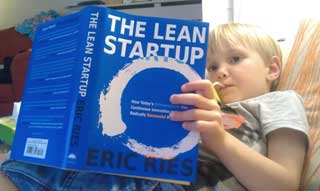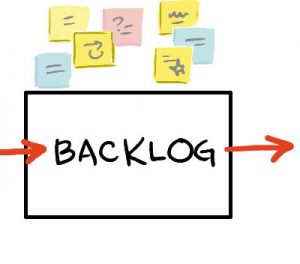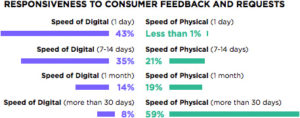
Eric Ries has given us a wonderful book in The Lean Startup. It is by far the best guide (along with Steve Blank’s books) for entrepreneurs looking for method, not magic, for growing their startup. But where does the title come from? What’s lean about lean startup? And what does this have to do with Agile Marketing? I’ll answer both of those questions below.
Eric Ries coined the name Lean Startup from his study of Lean Manufacturing techniques created by Taiichi Ohno and Shigeo Shingo of Toyota. So that’s one answer to our question – what’s lean about lean startup is that it’s modeled after lean manufacturing. But there is another sense in which lean startups are lean, and I need to review a little history in order to explain this sense of lean.
Fat Startups
During the Dot-Com bubble of the late 90’s, the message from VCs to startups was to grow revenues as fast as possible and worry about profitability later. Companies like Pets.com and Webvan raised huge amounts of capital, spending it as fast as they could raise it, only to collapse when common sense re-asserted itself and the bubble burst. The motto was “get big fast” and worry about profitability later. These wasteful startups could be called Fat Startups.
Partially as a response to the waste of capital and loss of huge amounts of money during the bubble, VCs and entrepreneurs became smarter and started to figure out how they could grow companies in a way that was more capital efficient. So this is another sense in which lean startups are lean – they are capital efficient, achieving scale with less waste, both in terms of time, effort and money.
Avoiding Pre-Mature Scaling
The Startup Genome Project has taken a data driven, rather than anecdotal, approach to understanding what works and what doesn’t in early stage startups. One of their findings has been that premature scaling is the most common reason for startups to perform poorly and fail. Startups must prove out the need for their product or service and the viability of their business and sales model before spending their hard-raised capital scaling the team. Startups that don’t prove out need and viability, and spend their capital before achieving these milestones, scale pre-maturely, and this often leads to failure. At the least, it’s a path to “Fat startups”.
Mark Leslie and Charles A. Holloway wrote about a similar concept in 2006 in the Harvard Business Review. They called their concept “The Sales Learning Curve“. Leslie, who had spent time at Intel before founding Veritas, was very familiar with the “Manufacturing Learning Curve”, where silicon manufacturers spend vast amounts of money learning how to make the first version of a chip, and then learning how to drive down the costs of manufacturing that chip. Applied to startups, Leslie and Holloway argued that startups must learn how to create a repeatable and scaleable sales process before they hire a large sales force. Without this learning, the company wastes capital paying for sales reps who stall when hired because their is no repeatable sales process.
This is another way that lean startups achieve “leanness” – they learn with a very small team until they achieve product-market fit, and only when that product-market fit is achieved, and a viable business model is identified and proven, do they scale up the company. This avoids pre-mature scaling, and is consistent with Leslie and Holloway’s Sales Learning Curve.
Technology Leverage
A second way that today’s lean startups achieve leanness is through the adoption of technologies like cloud services and open source products. In the dot-com bubble of the 90’s, companies that wanted to get a product to market had to buy and manage their own infrastructure. Typically, they did this with very expensive and proprietary hardware and software, like Sun Servers and Oracle databases. Companies would spend at least hundreds of thousands of dollars and sometimes millions establishing their own data centers in order to deliver a product to that first customer. They also had to purchase for peak capacity and they had little to no ability to scale down if they later found out that they didn’t need that peak capacity.
Today, companies can use technologies like Amazon Web Services or Microsoft’s Azure to quickly and cheaply deliver a minimum viable product for testing their ideas. Companies can literally deliver their first product to market for a thousand dollars or less. If they achieve some success, they can quickly scale up these services to meet demand. Only after they achieve product market fit do some of them create their own infrastructure, and some companies, like Netflix streaming, never create their own infrastructure.
There are also thousands of free or low-cost products that can be used by startups to create infrastructure and to test their way to success. Here are lists of startup tools from PBworks and Startup Weekend. These open source and low costs tools help companies create products and learn from the market without spending a ton of money, providing another avenue to achieving “leanness”.
What Does This Have to Do With Agile Marketing?
Even if you’re not working in an early-stage startup, the lessons of Lean Startup apply. When we begin a new marketing campaign, we are in learning mode. Where possible, we need to keep it lean until we prove that the campaign works, then we can scale up the spend. Too many traditional marketers plan big campaigns, spending big bucks, only to search at the end for favorable data to justify all that money spent. As Agile Marketers, we need to iterate with smaller spends until we learn that the campaign works, and then we can scale up the spend. This is a much more capital efficient way to spend our marketing budgets, and ultimately results in greater success and fewer failures.




I totally agree. You share wise words and thoughts, and very applicable to other areas of knowledge, “As Agile Marketers, we need to iterate with smaller spends until we learn that the campaign works, and then we can scale up the spend. This is a much more capital efficient way to spend our marketing budgets, and ultimately results in greater success and fewer failures”. Regards from Barcelona, David Marti
David, thanks for the kind words.